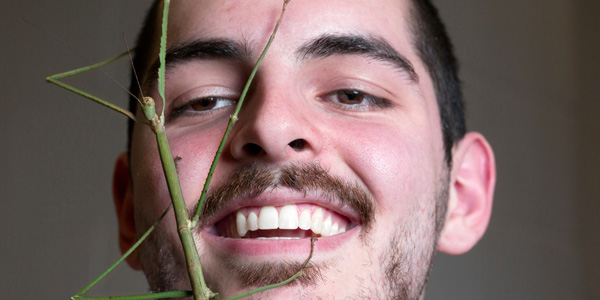
Tiny Ambassadors for Science
Ginny Mitchell has a fondness for something that may make other people’s skin crawl. She loves insects, and has made a career out of it.
Mitchell has worked for Iowa State for five years in the Department of Entomology, running the Insect Zoo. She takes the Insect Zoo around Iowa providing educational programs and exhibits.
Two new species were added to the Insect Zoo’s collection of 100 species last year—the Malaysian giant walking stick and the Hercules beetle. The Insect Zoo purchased a male and female of both species, although the female Hercules beetle did not survive the import process from Taiwan.
The Malaysian giant walking stick is the third largest insect in the world, behind two other species of walking sticks. It can detach its legs when it feels threatened, and then can grow them back.
The male Hercules beetle has long horn-like pincers extending from its head. It could make short work of cracking open a nut because the pincers can grow up to two to three inches long. The pincers are used in mating rituals and fighting over food.
20 years of engaging, educating
This year, the Insect Zoo is celebrating its 20th anniversary. In 1997, it began as an entomology outreach program to engage kids in the life of insects, using a hands-on approach.
“Our mission is to introduce children to arthropods,” Mitchell says. “This includes insects, spiders, tarantulas, millipedes, centipedes and scorpions. We want to teach them their biology and importance to our environment. People may think cockroaches are disgusting, but really they are the garbage collectors of our planet. We couldn’t live without them. We also want to give people an appreciation for an animal that is usually stepped on.”
Mitchell created a course based on the state’s core curriculum so science teachers can bring the zoo into classrooms. The zoo meets the requirements for teaching about metamorphosis, insect defenses and their roles.
“Insects are essential to Iowa. Without ants to till the soil, cockroaches and beetles to break down dead animals and plants, bees and flies to pollinate plants and mayflies and caddisflies to keep the waterways clean, none of our ecosystems could function,” says Joshua Byrne (’17 animal ecology) who worked with Mitchell as an undergraduate. Byrne is currently employed at the Little Rock Zoo in Arkansas, and is a classroom teaching assistant at Pediatrics Plus Developmental Preschool.
The Insect Zoo’s goal is to present many different species to spread knowledge.
“Diversity is key. Arthropods are the most diverse animal on this earth. There are more arthropods than any other animal combined,” Mitchell says. “If we can display the diversity within this group of animals, then people will be even more amazed and appreciative.”
Have bugs, will travel
The Insect Zoo obtains species from different institutions that import the insects. Mitchell also travels to Arizona to gather insects from the desert. At an Insect Zoo event, Mitchell will bring five to 100 species. She chooses insects based on their ability to adapt to diverse situations and their hardiness. Mitchell carefully watches over and protects them during handling.
Mitchell’s favorite memory is from one school demonstration. A second grader ran up afterwards and handed her a drawing of the two of them. The little girl wrote: “I want to be like you when I grow up.”
The Insect Zoo has been growing in popularity. In 2016, Mitchell presented more programs than in the entire 20-year history. It was featured at 355 events at schools, birthday parties, nursing homes, daycares and fairs. In 2016, the zoo reached more than 34,000 Iowans.



